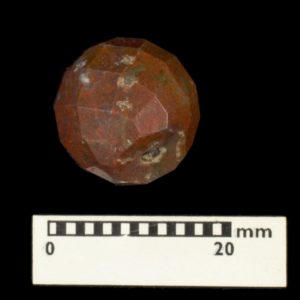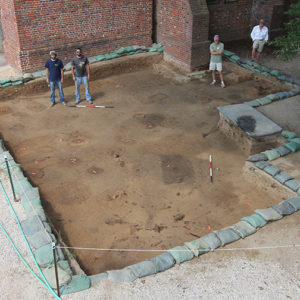The L-shaped cellar near James Fort’s first well has been found to have a brick feature at its southeast end, steps at its north end, and a host of interesting artifacts in between.
The cellar is 25 feet long and dates to the early James Fort period (1607-1610). It is in an area west of the brick church tower and north of the rediscovered 1608 church. This cellar aligns with James Fort’s first well, which sits just 10 feet away to the west and at the same angle.
“It’s not just a straight-down cellar. There are other things going on, such as possible compartments or partitions,” said Jamestown Rediscovery archaeologist Mary Anna Richardson.
Archaeologists began to explore the brick feature at the end of the cellar in mid-July. The brick stack measures about three feet and features noticeably precise mortaring. It is smaller than the bread ovens previously found in a cellar to the north of this feature.
Colony President Edward Maria Wingfield wrote that in early 1608 “Captain Newport . . . employed some of [his men] about a fair storehouse others about a stove,” which might mean the brick feature was a heating source for metallurgical testing.
The 2012 Field School students worked on the cellar just before finishing their summer on the site on July 13, and the conservation lab has been busy with the artifacts that continue to come out of the cellar.
The cellar has fill from the June 1610 clean-up of James Fort, ordered by the newly-arrived Lord Governor and Captain General of Virginia, Lord De La Warr. So the cellar has this summer produced many blue trade beads and glass and copper objects. Archaeologists have found a large pair of shears, an ivory die and clay balls for gaming, several Irish pennies, and an iron buckle.
A quartz crystal projectile point from the cellar is a smaller rendition of the quartz point found in 2001 in a pit just north of the 17th-century church tower and now on display in the Archaearium. The half-dozen quartz points found on the site over the years are almost clear and free of impurities—made of the closest substance to glass that the Indians had. Such an object of clear quartz may have had spiritual meaning to the Indians or cemented an important trade of goods between English and Indian.
The cellar has also produced a red carnelian bead made in India. Other such beads have been found on the James Fort site. This one has many well-defined facets.
 This summer has also featured work at the seawall with a Flote-Tech machine designed to separate plant remains from soil using water agitation and forced air delivery. Often these plant remains are preserved in the soil by carbonization—being burned in low- or no-oxygen environments. Plant artifacts — also called “archaeobotanical remains”—recovered from the fort can describe food the colonists ate, the kinds of trees they used for fuel, and what plants and animals were imported from Europe to North America.
This summer has also featured work at the seawall with a Flote-Tech machine designed to separate plant remains from soil using water agitation and forced air delivery. Often these plant remains are preserved in the soil by carbonization—being burned in low- or no-oxygen environments. Plant artifacts — also called “archaeobotanical remains”—recovered from the fort can describe food the colonists ate, the kinds of trees they used for fuel, and what plants and animals were imported from Europe to North America.
A six-week summer internship allowed Miles Maynes, a Utah State University student, to go through bags of soil from years of James Fort excavations, looking for material so small it needs to be studied under a microscope after the flotation machine defines it. Maynes and the volunteers working after his internship ended have done about six bags of soil a day in the mission to sift through 289 bags.
Meanwhile, there is a lot of information coming out of the eight different 10-by-10 foot units opened just south of the 1907 Memorial Church—but so far nothing conclusive about the construction of the tower that stands at the west end of the church. Two postholes have been found that line up with tower features, but there has not been a clear posthole pattern that would indicate scaffolding in the construction of the tower.
Carl Lounsbury, senior architectural historian at the Colonial Williamsburg Foundation, met with the 2012 Field School students in the last week of June to describe the churches at Jamestown and observe the work in the archaeological units by the church.
After reviewing the open units, Lounsbury said, “There’s no liturgical reason for the tower here. Towers are useless. They are an extreme waste of money. But because you can do it, it shows you are powerful.”
related images
- A Carnelian bead from India found in an early James Fort cellar
- A quartz projectile point from an early James Fort cellar
- An ivory gaming die found in an early James Fort cellar
- Overview of the site south of the church tower.









